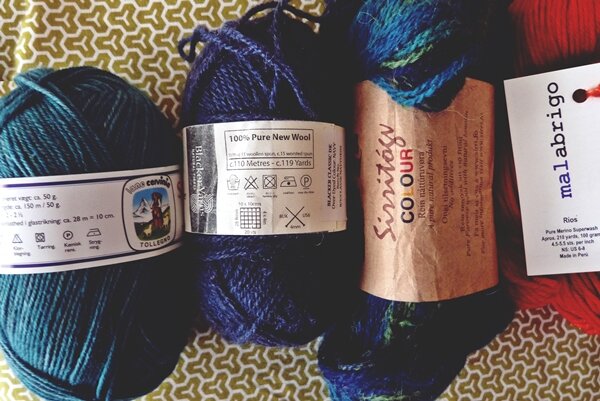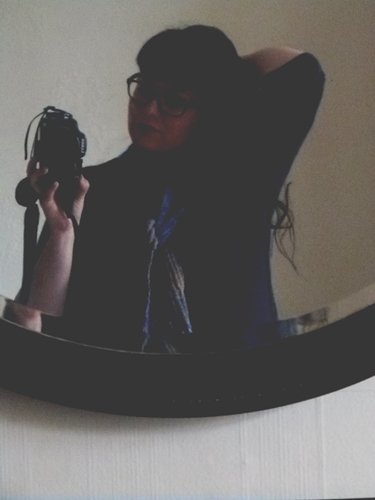Earlier this month I was asked to compile a list of 4-ply/fingering-weight yarns available in the UK and suitable for colourwork. I asked my Twitter followers for their favourite yarns, and the resulting thread was so wonderful that I decided to share the tips with you.
Designing and knitting colourwork will always be something I love doing. Colour combinations are endless and it is so satisfying to see a colourwork stitch pattern begin to form. While it may look daunting to beginners, colourwork knitting has its own logic and rhythm to it. Through my years of teaching colourwork, I’ve learned that finding the right yarns is key to a successful project.
So, here is a list of some of the excellent yarns you can use if you are a UK-based knitter (or if you want to use a British yarn).
The Classics:
Jamieson’s of Shetland and Jamieson & Smith are the two classic Fair Isle yarns. The two companies both sell genuine Shetland yarn in a myriad of colours.
One of Scotland’s best kept secrets is JC Rennie whose yarns include both a Shetland-like 4ply and a Supersoft Lambswool 4ply. You might have seen the Lambswool 4ply sold under other labels, but the full colour range is available from Rennie. Wee County Yarns sell 10g mini-balls of Rennie which allows you to combine a lot of colours without committing to full balls.
John Arbon is always incredibly popular at shows and it is easy to see why when you look at their range of yarns. Knit By Numbers 4ply comes in 100+ colours and the set-up makes it easy to choose and mix colours across the whole range. Their Exmoor Sock 4ply is a classic sock yarn that comes in 13 colours that all work well with each other.
Garthenor in Wales has several 4 ply yarns perfect for colourwork. Their Preseli comes in a stunning array of colours while their Number 2 is all about natural sheep colours.
Designer-Led Yarns:
Marie Wallin has developed her own British Breeds Yarn which comes in an array of beautifully heathered colours. Marie used to be Head Designer at Rowan Yarns and her eye for colour continues to be classic and subtle.
Another designer with a strong sense of colour is Susan Crawford whose Excelana 4ply is influenced by Susan’s love of vintage fashion. Excelana has a nice grip which makes it excellent for colourwork.
The name Alice Starmore is synonymous with incredible colourwork designs and it’s no wonder she has her own yarn. Starmore’s Hebridean 2-ply is a beautiful yarn available in painterly colours.
And Milarrochy Tweed from Kate Davies is another design-led yarn with a beautiful palette. The addition of mohair to the fibre blend gives it a subtle halo as well as good grip.
Yarn Shops’ Own Yarns:
Looking beyond designers with their own yarns, let’s look at yarn shops. Two yarn shops that popped up in the comments were Wensleydale Longwool Sheep Shop which has developed their own 4ply yarn (which comes in 25g balls - perfect for projects where you need plenty of colours, but only a small amount of each) and Baa Ram Ewe whose Pip Colourwork also comes in handy 25g balls and has proven popular.
Indie Dyers:
British indie dyers are also dyeing yarns perfect for colourwork and many offer miniballs or small set-ups too.
Gathered Sheep Yarns dyes gorgeously sheepy yarn in deep, autumnal colours. Giddy Aunt Yarns goes for a clear, saturated colour range.
One of my favourite yarns is Kettle Yarn’s Baskerville 4ply which comes in a beautiful set of colours which reminds me of stones or minerals. Baskerville is a Gotland/BFL mix which makes for a nice, toothy yarn. Their Northiam 4ply is pure BFL and slightly loftier with strong, confident colours.
In Wales, Triskelion Yarns dyes a beautiful Corridale 4ply in their signature semi-solid colours.
Another of my favourite dyers is RiverKnits whose science background is evident is how she works with colours. Severn 4ply is a woollen-spun 4 ply weight yarn with a warm, woolly handle thanks to the Jacob fleeces used in producing the yarn.
The delightful Bluebell Yarns have a host of 4-ply breed specific bases. I have my eye on the Falkland/Corridale base for colourwork purposes.
Meanwhile, Marina Skua’s hand-dyed Mendip 4ply showcases a truly wonderful colour range (some of those oranges and yellows are on my mind) and the base is a sourced Shetland-cross.
Small Flock/Farm:
Whistlebare produces yarns from their own flocks and their Cuthbert’s Sock 4ply has a satisfying crunch to it. At time of writing they were waiting for the new Spring 2021 spinning to drop.
One yarn I keep wanting to try is Uradale Yarns’ natural Shetland 4ply. You can also buy organically dyed yarn from them, but my eyes keep being drawn to the natural sheep shades. They are stunning.
And The Grey Sheep Co. also has a lovely selection of 4ply yarns. They comes in both full skeins and mini-sets. The colour palette is muted with a slight hint of variegation.
Black Isle Yarns from the Scottish Highlands has a very fine sportweight that I’m assured leans into 4ply category: Auchen. And The Birlinn Yarn Company from the Outer Hebrides makes an exquisite 4ply that is inspired by the incredible landscape around them.
One of my favourite yarns is Cartref DK and it thankfully also comes in a heavy 4ply. It is a pure Welsh yarn: Welsh sheep and spun/dyed in Wales by careful specialists.
Doulton Border Leicester is a no-kill farm focusing on a rare sheep breed. Their 4ply yarn comes in 27 jewel-like colours and is smooth to work with.
These are the yarns I’ve compiled thanks to my own experiences and also Twitter suggestions. I have left out most commercial yarns or any imported yarns (although there are plenty of those available in the UK too and many are excellent). I urge you to keep exploring yarns and have fun along the way!
- Karie





















